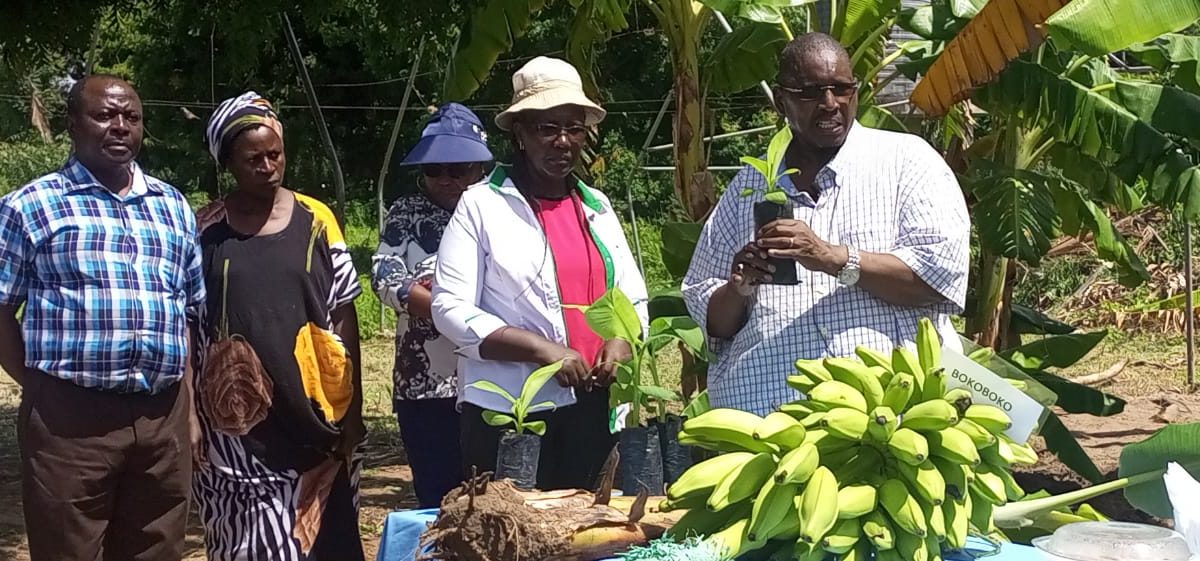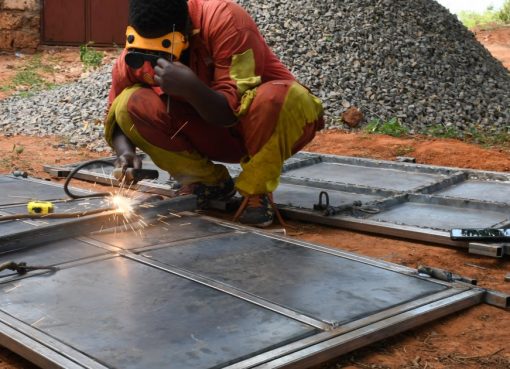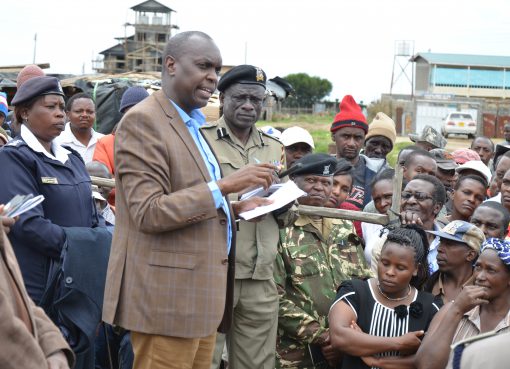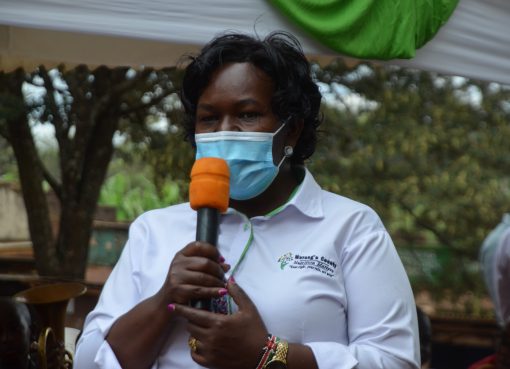The potential of cooking banana (matoke) production has not been fully exploited except in parts of Nyanza where it is an important staple food.
Kenya has over 400,000 small holder banana farmers with 1.7 percent of Kenya’s total arable land planted covered by bananas but most of them are used to growing the dessert ripening banana leaving a big gap for cooking and plantain varieties.
Kenya Agricultural Livestock and Research Organization (KALRO) is currently improving production of cooking banana and plantain through identification of banana and plantain varieties that could be introduced in different agro-ecological zones of Kenya especially the coast region.

KALRO Director General Dr. Eliud Kireger said there is need to increase the genetic diversity of cooking banana and plantain in different regions in order to meet the requirements of the consumers and enhance producers’ income.
This, he added, would further meet increased demand for cooking banana and plantain in urban areas and at the same time ensure national food and nutrition security, and increased incomes for farmers.
“We have as KALRO been undertaking research by evaluating at least five banana and plantain varieties that validates appropriate pest management strategies and utilization before the technology is cascaded to the farmers,” he said.
Through the research done, the DG added that KALRO would now be able disseminate banana and plantain technologies and avail clean planting materials to at least 1000 farmers and stakeholders in each target County.
Dr. Kireger who was speaking in Mtwapa during a field day visit on the banana project said the focus on cooking banana and plantain is because of changing habits and demand in terms of what the market wants unlike before.
“The cooking banana and plantain is different from the dessert bananas. They are good in terms of high level of antioxidants which is important to our health and the industry is also lucrative,” he said giving an example of one finger of plantain at the market sells at between Sh50 to Sh80 while the ripened single banana goes for Sh5
Currently the DG said that Kenya has around 71,000 hectares of bananas which contribute to Sh25 billion annual income in a production of 1.5 metric tonnes of the product.
Dr. Kireger thanked the Government Agency, National Research Fund (NRF) for funding the project to the tune of Sh13.5 million saying the impact of the project in which they were partnering with Jomo Kenyatta University of Agriculture and Technology (JKUAT) would see over 700 farmers being trained in the technologies and they in turn would train other farmers and ensure are economically empowered and the country is food secure.
KALRO Senior Scientist and the Principal Investigator of the Project Charity Gathambiri said that one of the main challenges that farmers have been facing is planting materials for plantain bananas.
To solve this problem, she added that they used a tissue culture protocol that was developed using some of the varieties they had gotten in the banana growing areas across the country.
“We collected 50 cooking bananas and plantains germplasm and planted them at KALRO Horticultural Research Institute Kandara. Two evaluation trials were established, one at KALRO Kandara for cooking varieties Nusu Ngombe, Kiguyu and Mogaka 1 and plantains Bokoboko, Mkono wa Tembo, and Kampala,” she explained.
The second evaluation trial, she added, is at KALRO Mtwapa for cooking varieties Ngombe, Gichagara, and Namunge, and plantain Gikono, Kabuu and Bokoboko.
“These were selected for suckering ability, stem size, plant height, and days to maturity among other considerations, while yield parameters included bunch weight, number of hands, and fingers, finger length and thickness,” she said.
Gathambiri noted that so far farmers in Central, and Coast established demonstration sites at Nyeri and Kilifi for eight (8) cooking banana, four plantains and four cooking varieties, of which two namely boko boko and Mkono wa Tembo were selected for commercialization.
She added that for the cooking banana, farmers have been trained on value addition products such as banana flour, banana crisps and chips from cooking banana, and banana fritters and for plantains, farmers were enlightened that it was best when roasted which most people are not aware of.
“As KALRO we have brought in diversification of the banana farming in the industry to move from the dessert ripened to the cooking and plantain banana whose selling price will give farmers good returns.
Through the project which will be ending by this financial year, Gathambiri explained that they have introduced a macro propagation method, which is a traditional method that farmers could use in the field to get their own planting materials for the plantain bananas and this would help in them practicing, multiply and be able to have enough planting material of their own.
She added that farmers have already embraced the technology, especially the youth who have been participating in the demonstration sites.
“We are happy that this project by NRF looked straight to the actual needs of the local people and instead of export market we concentrated on the local markets,” she said adding that the gap they were trying to bridge is where farmers have reached a point where they were feeling the monotony of growing desert banana.
“ KALRO is coming in and having farmers diversifying to other types of banana and the production will eventually go higher by bringing in new types of banana especially the cooking and plantain whose gap is yet to be filled,” Gathambiri said .
KALRO Director in the Department of Agriculture Research Fund Henry Tanui said they were currently coordinating 24 projects funded by NRF and the banana one was on course, sustainable and would create a lot of changes in terms of food security and nutrition as well as empower farmers in terms of earnings.
Tanui said the farmers would get the cuttings for KALRO as well as the technology because scientists would visit farmers, empower them and disseminate the information that is relevant to them.
A Research Technologist at the Horticultural Research Institute (HRI) Pauline Kinaga said introducing the cooking banana and the plantain for the farmers was a good thing since the agronomical methods and establishment used were the same as those used in production of the ripening bananas.
She however warns that in order for the crop to be successful, farmers needed to get clean planting materials which HRI offers at Sh130 per sucker with an acre requiring around 450 suckers and within 9 months using tissue culture, one is able to harvest their crop.
Magdalene chanzera, a farmer from Kakuyuni in Malindi said since childhood, her family has been engaged in the ripening banana production but due to harsh climatic conditions and water clogging, their farms had been destroyed.
“The new technology being brought by KALRO is a blessing to the farmers in the area, since we have never planted plantain before and we want to thank them for giving us planting material for this new varieties that will improve our yields and incomes,” she said.
“We grew up growing bananas but mostly just for eating and cooking and selling a bit to our neighbours but now with the new varieties, my kids will be able to go to school and I will be able to sell plantain whose demand is high and sells at a good price,” she said.
Chanzera said the biggest challenge they have been having as farmers is water which she learnt is a major component if one wants a good yield of banana.
“I have invested in a borehole and although the water is not enough, I can see my crop bearing fruits and my neighbours are even coming out to envy me,” she said.
She called upon her fellow farmers not to rely so much on the same crop but learn to diversify so that if one crop failed, they could rely on the other.
Banana has been ranked first among all the fruits grown in Kenya. The four main types of bananas grown in Kenya and East Africa based on their utilization namely dessert, cooking, roasting and brewing.
In 2019, the area under banana production was 71,102 Ha with a total production of 1.51 million tons valued at Sh24.62 billion.
The KALRO banana 3-year project dubbed, “Enhancing Productivity and Commercialization of Banana and Plantain for Food and Nutrition Security through Development and Dissemination of Technologies” has been undertaken with support by the National Research Fund (NRF) a government agency that supports research in aspects of science technology and innovation.
By Wangari Ndirangu





